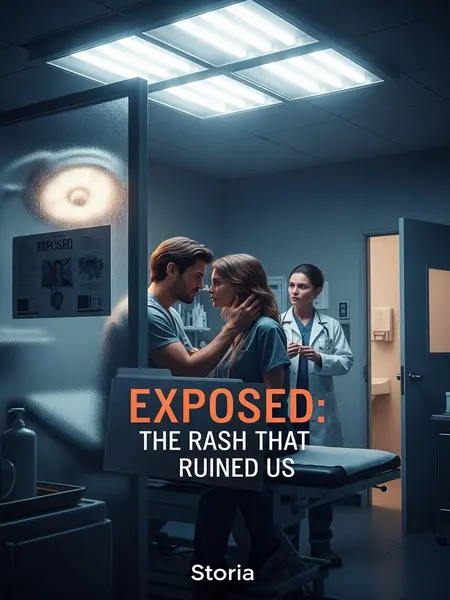Chapter 2: Unraveling the Diagnosis
Shingles and pityriasis rosea can look similar; it’s easy to get them confused.
But the pattern and the location told the story. Medical textbooks come alive when you see these cases in real life.
Here’s something you might not know: Dermatology clinics spot a lot of STDs. It’s not all acne and warts—sometimes it’s detective work, unraveling the tangled threads of someone’s life.
Many STDs show up first as skin problems—HIV rashes, syphilis, HPV bumps, you name it.
So, was this syphilis or HIV?
I had a good idea, but couldn’t say it out loud. I needed the labs.
Every good doctor knows: Don’t assume, even when you’re sure. Lab confirmation saves a lot of heartache.
I reminded the med student, "Don’t jump to conclusions before the results come back. Keep the patient calm so things don’t get heated."
Syphilis and HIV rashes are different, but neither is very specific.
To be thorough, I ordered both syphilis and HIV tests.
When he saw the order, the boyfriend jumped up, eyes wide. "Syphilis? HIV? I came in for eczema! Just give me a cream. Why are you running all these tests?"
His voice was sharp, anxious—like someone who’d just heard news they weren’t ready for. The room felt smaller, the air thick with dread.
His girlfriend stayed calm: "Just listen to the doctor."
Her voice was gentle, but with a quiet authority—like she’d already decided to see this through.
I explained, "This isn’t just eczema—especially with that scaly rash in your groin. It could be an STD."
I kept my voice as steady as I could, hoping to ease the tension. The med student watched, scribbling notes.
The boyfriend stared at me, then fell silent.
Sensing his embarrassment, the girlfriend took over:
"No way, doctor, my boyfriend would never…"
She trailed off, her voice catching, her eyes darting between us. The distance between them seemed to widen, as if she was clinging to a story she wished was still true.
I cut in gently:
"We need to run these tests. If your boyfriend has something, you should get checked too."
The room fell silent for a long moment.
You could almost hear the clock ticking, or maybe just the weight of things left unsaid.
As the saying goes, you don’t know how bad it is until it hits home.
The boyfriend said, "Forget the HIV test. I’ve seen pictures online—mine doesn’t look like that. Just test for syphilis."
He spoke quickly, defensively, as if narrowing the tests could keep the diagnosis at bay.
I insisted, "It’s best to check both, just to be sure."
He snapped, "Are you just trying to rack up my bill? No HIV test—just syphilis."
He started tapping his foot, fast and anxious, like he wanted to bolt.
His arms crossed tight, jaw set. For a second, I wondered if he’d just walk out.
His girlfriend tried to soothe him, tugging at his shirt, "It’s fine, just do both. It’s just a test—it doesn’t mean you have anything. It won’t take long."
She sounded almost pleading, her hand hovering near his as if hoping to anchor him.
He shot back:
"I’m not testing for HIV! If the cream had worked, I wouldn’t even be here. Two months ago, when my eczema flared up, the doctor told me to rule out syphilis. The test was negative."
His voice trembled—half anger, half fear. He looked away, avoiding my gaze.
Since he was so resistant, I compromised: "Let’s just test for syphilis first."
Sometimes you pick your battles. I wrote the orders, making a note to revisit the HIV test if needed.
I ordered several syphilis markers: RPR (Rapid Plasma Reagin), VDRL (Venereal Disease Research Lab), FTA-ABS (Fluorescent Treponemal Antibody Absorption), and TPPA (Treponema Pallidum Particle Agglutination Test).
Here’s a tip for reading syphilis tests: To see if syphilis is still active and needs treatment, check RPR and VDRL. If both turn negative and stay negative, syphilis is considered cured (I’ll explain more about that at the end).
FTA-ABS and TPPA usually stay positive for life—they just show you’ve ever had syphilis. If you already know you’ve had it, retesting these doesn’t help.
I could see their eyes glaze over—nobody comes to the doctor hoping for a pop quiz on blood tests. I broke it down simply, glancing at the girlfriend to make sure she understood.
The guy snatched the test slip and stormed out to get his blood drawn.
She flinched at the slam, her shoulders curling inward, as if she could make herself smaller.
Seeing such a classic syphilis rash, I turned to the girlfriend, a new worry gnawing at me.
"When was your most recent sexual activity?" I asked.
She blushed, hesitated, and said quietly, "About four weeks ago."
Her voice barely rose above a whisper, gaze locked on the floor. In moments like this, the clinic felt less like a sterile box and more like a confessional.
"Did you use protection?"
She answered, "We always use condoms. I thought that was just for not getting pregnant, though."
Oh boy. I always figured everyone knew condoms help prevent STDs, but moments like this remind me how often the basics get missed—especially for young adults navigating new territory.
"Think of condoms as your seatbelt—it won’t prevent every accident, but you’re a lot safer with it on. Condoms don’t just prevent pregnancy—they block about 99% of STDs: HIV, syphilis, gonorrhea, chlamydia. Unprotected sex is a huge risk."
Her eyes widened, like she was hearing this for the first time.
"So, if I used protection, is the risk still high?"
"There’s still some risk for syphilis, but it’s much lower."
Even with protection, close contact—like sharing towels or bathrooms—can sometimes spread syphilis.
A lot of people think STDs only spread through sex. But syphilis is sneakier than HIV—more contagious, and can even spread through everyday contact, like sharing towels at home. Still, the main route is unprotected sex. With protection, the risk drops a lot.
I asked, "Have you noticed any symptoms? A painless sore, or a rash like your boyfriend’s?"
She hesitated, so I softened my tone: "Any odd bumps, spots, or anything that just doesn’t feel right? Even if it seemed to go away?"
I suggested she get checked anyway. If she did have a sore, it’d be a valuable teaching case for the med student.
Syphilis has three stages: The first is a painless sore; the second is a rash; the third can affect any organ in the body.
The med student scribbled notes, glancing up, eager for a glimpse of something he’d only read about.
He’d just drawn the curtain when the girlfriend looked at him and asked, "Doctor, why is he here too?"
She looked embarrassed.
I explained, "He’s a med student, here to learn. I was a student once, too. Don’t worry—we’ll be professional and respectful."
I gave her a reassuring smile, nodding to the student to step back a bit if she preferred. Hospital policy required a chaperone for intimate exams, and I wanted her to feel safe.
She blushed but didn’t object, so we went ahead.
A lot of patients are uncomfortable with students present for sensitive exams. I always explain first and respect their wishes—every doctor starts as a student, and you only learn by seeing real cases. Real life rarely follows the textbook.
After the exam, she had neither a sore nor a rash.
She let out a shaky breath, relief flickering across her face, but her fingers still twisted nervously in her lap.
So, she probably wasn’t infected—but I couldn’t say for sure yet.
Until the test results came back, I couldn’t promise, "You’re definitely fine."













